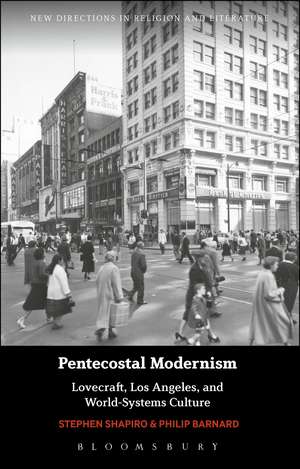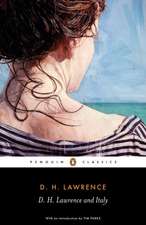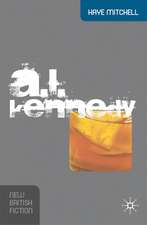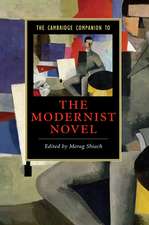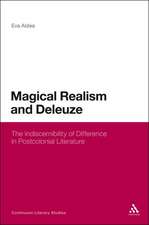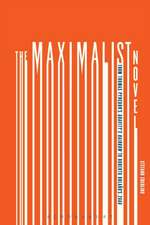Pentecostal Modernism: Lovecraft, Los Angeles, and World-Systems Culture: New Directions in Religion and Literature
Autor Professor Stephen Shapiro, Professor Philip Barnarden Limba Engleză Paperback – 22 aug 2018
| Toate formatele și edițiile | Preț | Express |
|---|---|---|
| Paperback (1) | 235.00 lei 6-8 săpt. | |
| Bloomsbury Publishing – 22 aug 2018 | 235.00 lei 6-8 săpt. | |
| Hardback (1) | 567.17 lei 6-8 săpt. | |
| Bloomsbury Publishing – 8 feb 2017 | 567.17 lei 6-8 săpt. |
Din seria New Directions in Religion and Literature
- 21%
 Preț: 215.96 lei
Preț: 215.96 lei - 30%
 Preț: 509.20 lei
Preț: 509.20 lei -
 Preț: 176.86 lei
Preț: 176.86 lei - 24%
 Preț: 195.56 lei
Preț: 195.56 lei -
 Preț: 192.27 lei
Preț: 192.27 lei - 30%
 Preț: 510.42 lei
Preț: 510.42 lei - 30%
 Preț: 510.03 lei
Preț: 510.03 lei - 30%
 Preț: 509.86 lei
Preț: 509.86 lei - 14%
 Preț: 175.91 lei
Preț: 175.91 lei - 30%
 Preț: 566.83 lei
Preț: 566.83 lei - 23%
 Preț: 190.87 lei
Preț: 190.87 lei - 21%
 Preț: 217.35 lei
Preț: 217.35 lei - 24%
 Preț: 195.37 lei
Preț: 195.37 lei - 23%
 Preț: 254.55 lei
Preț: 254.55 lei - 24%
 Preț: 188.55 lei
Preț: 188.55 lei - 14%
 Preț: 176.44 lei
Preț: 176.44 lei - 12%
 Preț: 215.88 lei
Preț: 215.88 lei - 14%
 Preț: 196.96 lei
Preț: 196.96 lei - 23%
 Preț: 192.55 lei
Preț: 192.55 lei - 14%
 Preț: 183.70 lei
Preț: 183.70 lei - 23%
 Preț: 191.38 lei
Preț: 191.38 lei - 23%
 Preț: 254.02 lei
Preț: 254.02 lei - 14%
 Preț: 176.86 lei
Preț: 176.86 lei - 14%
 Preț: 164.59 lei
Preț: 164.59 lei - 24%
 Preț: 190.33 lei
Preț: 190.33 lei - 22%
 Preț: 596.98 lei
Preț: 596.98 lei - 30%
 Preț: 508.95 lei
Preț: 508.95 lei - 30%
 Preț: 540.54 lei
Preț: 540.54 lei -
 Preț: 176.44 lei
Preț: 176.44 lei - 23%
 Preț: 254.55 lei
Preț: 254.55 lei
Preț: 235.00 lei
Preț vechi: 304.31 lei
-23% Nou
Puncte Express: 353
Preț estimativ în valută:
44.97€ • 46.95$ • 37.13£
44.97€ • 46.95$ • 37.13£
Carte tipărită la comandă
Livrare economică 15-29 aprilie
Preluare comenzi: 021 569.72.76
Specificații
ISBN-13: 9781350081628
ISBN-10: 1350081620
Pagini: 192
Dimensiuni: 156 x 234 x 11 mm
Greutate: 0.23 kg
Ediția:NIPPOD
Editura: Bloomsbury Publishing
Colecția Bloomsbury Academic
Seria New Directions in Religion and Literature
Locul publicării:London, United Kingdom
ISBN-10: 1350081620
Pagini: 192
Dimensiuni: 156 x 234 x 11 mm
Greutate: 0.23 kg
Ediția:NIPPOD
Editura: Bloomsbury Publishing
Colecția Bloomsbury Academic
Seria New Directions in Religion and Literature
Locul publicării:London, United Kingdom
Caracteristici
The first historical study of the pulp writings of H.P. Lovecraft against the backdrop of the American Pentecostalist religious movement
Notă biografică
Stephen Shapiro is Professor of American Literature at the University of Warwick, UK. He is the author or editor of 11 books, including How to Read Marx's Capital (2008) and The Wire: Race, Class, and Genre (2012).Philip Barnard is Professor of English at the University of Kansas, USA. He has published 11 books as author, editor or translator and is the Textual Editor for the Charles Brockden Brown Electronic Archive and Scholarly Editions.
Cuprins
AcknowledgementsPart A: Methods1) Modernism and the Capitalist World-System: Williams, Wallerstein, Foucault2) Combined and Uneven Development: World-System DynamicsPart B: Modernisms3) Pentecostalism and the Protolanguage of Racial Equality4) Lovecraft, Race, and Pulp Modernism5) Afterword: Social GospelBibliographyIndex
Recenzii
This book ... makes a carefully constructed, powerful intervention suggestive of much potential for future scholarship drawing on its principles of approach ... The ideas here will be useful to scholars working on other related fields linked to both Modernism and the Weird, from postmodernism to the New Weird and beyond. In particular, Shapiro and Barnard's construction of the experience-system of modernity seems useful in reevaluating the relative positions of less centric Modernists, or the concept of Intermodernism in the study and understanding of twentieth-century literature systemically, in the context of cultural fields, such as religion, from which it might otherwise be separated.
The brevity of Pentecostal Modernism belies its density, but not its accessibility. In fact, it is an enjoyable read that is both insightful and well-researched.
As a scholar of Pentecostalism, it was intriguing for me to observe how Shapiro and Bernard's efforts resituated familiar material in new domains.
The brevity of Pentecostal Modernism belies its density, but not its accessibility. In fact, it is an enjoyable read that is both insightful and well-researched.
As a scholar of Pentecostalism, it was intriguing for me to observe how Shapiro and Bernard's efforts resituated familiar material in new domains.
